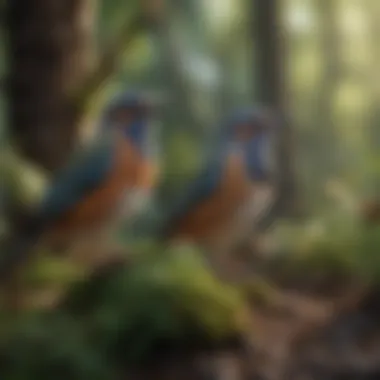Encountering Birds Up Close: A Unique Experience


Intro
The phenomenon of observing a bird up close can evoke a spectrum of emotions and thoughts. It is a unique experience that blends curiosity, tranquility, and insight. As cities grow and natural habitats shrink, encounters with avian companions during daily life become rare. This article explores the significance of these moments, aiming to deepen the understanding of human interactions with birds. Observing a bird near you can be transformative and offers a deeper appreciation for nature.
Understanding Your Pet
If you have a pet bird, understanding its behavior and needs becomes crucial. Birds, like all animals, have specific traits and habits that govern their interactions with people and their environments. Recognizing these can help you form a better bond with the birds you encounter.
Pet Behavior Basics
Birds exhibit various behaviors that reflect their health and emotional state. For example, a bird that is preening itself signals contentment, while a puffed-up posture may indicate discomfort or stress. Understanding these basics can enhance interactions with wild birds too. When you see a bird near you, its body language can reveal much about its feelings and intentions.
Common Breed Characteristics
Different bird species have unique characteristics. Parakeets are known for their sociable nature, while canaries are often more solitary. If you come across birds like those in your neighborhood, recognizing their types can enhance your appreciation of their presence. Familiarity with these breeds can guide your expectations of their behavior.
Species-Specific Needs
Every species has specific needs ranging from diet to habitat. For example, finches prefer seeds, while parrots benefit from a variety of fruits and vegetables. Knowledge of these requirements also extends to wild birds. When you identify a bird species near you, understanding its needs could lead to more fruitful encounters, allowing for mindful wildlife interactions.
Observing Bird Behavior and Interaction
The act of observing birds involves more than simply watching; it requires patience and mindfulness. Each movement tells a story that can enrich your experience.
Responding to Environment
Birds adjust their behaviors based on environmental factors. Noise, weather changes, and human presence can impact how they act. Observing how a bird reacts to these elements can be enlightening. For instance, a curious bird may approach if the area is calm, but it might retreat at a sudden noise.
Importance of Patience
Birdwatching involves waiting quietly and allowing birds to become comfortable in your presence. This patience often rewards the observer with breathtaking moments. Engaging in birdwatching encourages a deeper connection to wildlife.
Appreciation and Conservation
Encounters with birds can foster a love for nature. Such moments encourage individuals to advocate for conservation efforts.
Promoting Awareness
Awareness of local bird species and their habitats can lead to more support for preservation initiatives. Understanding the ecological role that birds play can inspire people to protect the environments that sustain them.
Community Engagement
Participating in local birdwatching groups can enhance the experience. Sharing observations can build a community focused on appreciation and conservation of avian species. Engaging with others fosters a collective responsibility towards wildlife.
The simple act of observing a bird can open one's eyes to the intricate connections within the ecosystem.
Ending
The experiences derived from observing birds are not merely passive. They urge an examination of our relationship with nature and our role as stewards of the environment. Understanding bird behavior, species traits, and ecological importance can deepen our appreciation of these avian companions. As humans interact with wildlife, mindful encounters become crucial in nurturing appreciation for the natural world.
Prologue
The experience of observing a bird sitting nearby may seem simple. However, it reveals layers of human (avian) interactions that warrant exploration. In this article, we examine how such moments influence not only our perception of nature but also our mental state and social behavior. Understanding these interactions is crucial as they form a bridge between our lives and the wildlife that surrounds us.
The encounter with a bird can serve many purposes. For some, it provides a moment of tranquility in a busy world. For others, it ignites curiosity about avian behavior and ecology. The emotional responses elicited during these moments can enhance well-being and encourage a deeper connection to nature.
Understanding Human (Avian) Interactions


The relationship between humans and birds has evolved over centuries. As we observe birds, we partake in a dance of mutual respect and fascination. Humans have a long history of being captivated by birds, often seen as symbols of freedom and beauty. This sense of connection can manifest in various forms, from birdwatching to keeping birds as pets.
There are several reasons why these interactions matter. These encounters can:
- Foster a sense of mindfulness, encouraging individuals to appreciate their surroundings.
- Promote curiosity about the avian world, which may lead to further learning.
- Strengthen emotional ties to nature, ultimately benefiting mental health.
From an ecological perspective, recognizing the significance of these interactions can raise awareness about conservation efforts. Every bird observed is a chance to appreciate the biodiversity of our planet. By understanding the dynamics of human (avian) interactions, we can pave the way for more respectful and informed ways to coexist with wildlife.
Thus, as we reflect on the experiences of birds sitting near us, we open up a dialogue about our role in protecting and celebrating the richness of the avian world.
The Fascination with Birds
Birds captivate the human imagination in diverse ways. Their varied colors, songs, and behaviors provide a source of fascination for many. This interest is not merely surface-level; rather, it delves into deeper connections we hold with nature. Fostering this fascination can enhance our appreciation for wildlife and its importance in our ecosystem. Engaging with birds encourages observation, reflection, and a respect for their role in our shared environment.
Evolutionary Perspective
From an evolutionary standpoint, the connection between humans and birds has rich roots. Early humans relied on birds for food and information about environmental changes. The sight of birds could indicate weather shifts or the presence of predators. Over time, certain species became integrated into human culture, leading to domestication and companionship. For example, parakeets and canaries have found homes in many households. This ties back to our innate curiosity about bird flight and migratory behaviors, as well as their unique adaptations.
Birds also represent a form of beauty and grace. Their ability to traverse the skies has inspired countless advancements in human technology, such as aviation. Observing birds can provoke thoughts about freedom and the limits of human capability.
Cultural Significance
Birds hold significant places in various cultural narratives throughout history. In art and literature, they often symbolize themes such as peace, knowledge, and love. For instance, the dove is a long-standing emblem of peace across multiple cultures.
In folklore, specific birds are regarded as omens, guiding humans in their decisions. Cultures across the globe have integrated birds into their traditions and myths. This highlights how interconnected human experiences and avian existence truly are.
Moreover, birds contribute to local economies through birdwatching tourism. Environments rich in avian diversity attract both enthusiasts and casual observers. This economic aspect reflects a growing appreciation for the ecological significance of birds.
The Science of Bird Behavior
Understanding bird behavior is essential for anyone interested in observing our avian companions. It provides insights into their actions, social interactions, and communication methods. This knowledge enhances our appreciation for birds and informs how we can interact with them safely and respectfully.
Species-Specific Behavior
Birds exhibit a remarkable diversity of behaviors that vary across species. Each species has its own patterns of foraging, mating, and nesting, influenced by its evolutionary history and environmental context.
- Foraging Techniques: Different birds employ varied strategies to find food. For example, woodpeckers use their pecking ability to extract insects from trees, while sparrows may forage on the ground for seeds. Understanding these behaviors helps birdwatchers anticipate where and how to spot certain species.
- Courtship Displays: Birds have unique rituals to attract mates. The elaborate plumage of peacocks and the intricate songs of songbirds serve to demonstrate fitness to potential partners. Observing these behaviors can be fascinating and reveal much about avian priorities during breeding season.
- Nest Building: Different birds construct nests in distinct ways. Some, like the weaver bird, create intricate structures, while others, such as robins, may opt for simpler designs. Each nest-building technique reflects the bird's habitat and available resources.
This species-specific focus not only enriches our viewing experience but also encourages conservation efforts. Understanding what each bird needs highlights the importance of protecting their natural habitats.
Understanding Territory and Hierarchy
Birds establish territories that are critical for breeding and feeding. A bird's territory typically contains the resources needed for survival and reproduction.
- Territorial Claims: Male birds often establish territories through vocal displays or physical presence. The enthusiasm in their songs during mating season is not just an invitation to mate; it's also a way to warn rivals of their boundaries. This behavior can be observed by watching how birds react to one another in their environment.
- Hierarchy within Flocks: Many birds live in social structures that establish pecking orders. Dominant birds often access better resources, influencing their survival and breeding success. Observing interactions in a flock can reveal these hierarchical relationships, providing insights into their social behavior.
Understanding both territory and hierarchy is crucial for birdwatchers and enthusiasts. It offers a lens through which behavior can be interpreted, enhancing observation and appreciation.
“Meaningful interactions with birds enrich our lives and foster a deeper connection with nature.”
By examining the science of bird behavior, we appreciate the complexity of these creatures. This knowledge allows us to observe more responsibly and builds a foundation for advocating for avian conservation efforts.
Experiencing the Presence of a Bird
The experience of having a bird nearby can be transformative. This moment allows a genuine connection with nature and instills a sense of wonder. When a bird decides to land close to an individual, it can spark various thoughts and feelings, making this encounter significant in multiple ways. Understanding this experience involves looking at initial reactions and emotional responses.
Initial Reactions


When a bird appears nearby, the first reaction can often be surprise or a rush of excitement. This moment disrupts the routine pace of life. People tend to stop and observe closely. Some may even feel compelled to capture this moment on camera or phone.
Physical reactions also play a role. Heart rates may increase, and breaths can become shallow. Eyes widen as the details of the bird come into focus. Observing feathers, markings, and behaviors becomes a focal point. These initial reactions highlight that humans have an innate response to wildlife.
As people process the encounter, curiosity often takes over. Questions arise about the species, its habits, and its environment. Engaging in this kind of observation enhances awareness, allowing individuals to appreciate the delicate balance of nature.
Emotional Responses
Following the initial reaction, the emotional impact of the encounter becomes evident. This can range from feelings of joy to a sense of peace. The presence of a bird can ground someone in the moment. For many, the beauty of observing a bird's behavior provides a respite from stress or anxiety.
Moreover, behaviors displayed by birds, such as singing or preening, can evoke a range of emotions. Witnessing nature's simplicity brings clarity and a sense of grounding, connecting someone to the present moment. Emotions like nostalgia or longing may also arise, especially if the individual associates birds with childhood memories or earlier experiences.
Encounters with birds provide a unique form of stress relief. Studies show that being near wildlife can elevate mood and promote mental wellness. This emotional response reinforces the value of caring for our avian companions and reminds us of the importance of safeguarding their habitats.
Observing birds can offer mental health benefits, acting as a natural remedy for stress.
In summary, the experience of having a bird nearby is rich with initial reactions and emotional depth. Understanding these factors encourages appreciation for avian species and highlights the significance of birdwatching as a means of connecting with nature.
The Role of Environment
The environment plays a crucial role in shaping the experience of observing birds. This influence can range from affecting the bird's behavior to impacting how a human perceives and enjoys the encounter. The surrounding setting contributes significantly to the quality and type of interaction one has with avian companions.
Different environments offer unique opportunities for bird watching. Natural settings, such as forests or wetlands, often provide rich biodiversity. In these areas, the presence of various species can lead to more dynamic interactions. Sounds, colors, and movements create a multi-faceted experience. Conversely, urban settings present their own challenges and distinct experiences. The adaptation of birds to city life reflects their resilience and resourcefulness, yet the environment can restrict certain behaviors or presence of species.
Urban vs.
Natural Settings
When comparing urban environments to natural ones, many factors come into play. Urban areas often host familiar species like pigeons and sparrows. These birds have adapted well, finding food sources in parks and human habitats. The interaction tends to be more predictable, as these creatures are accustomed to human presence.
In contrast, natural settings are often more vibrant and varied. For example, visiting a nature reserve can lead to encounters with species that are less common in urban areas. Observing behaviors such as nesting or foraging in a more suitable habitat is often an enlightening experience. The lushness of vegetation and availability of natural resources in these areas can encourage more diverse avian activity.
However, accessibility plays a big role. Many may find it easier to observe birds in urban gardens or local parks. In these spaces, one can still appreciate the companionship of birds without traveling far.
Factors to Consider in Urban Settings:
- Adaptation of Species: Birds that thrive in cities may display different behavior patterns compared to their wild counterparts.
- Human Impact: Noise and pollution can deter certain species, affecting diversity.
- Access: Urban parks offer easier means for families and children to engage with nature.
Advantages of Natural Settings:
- Biodiversity: Higher variety of species and behaviors.
- Natural Behaviors: More authentic encounters, revealing natural instincts in a suitable habitat.
- Health Benefits: Being in nature can reduce stress, heighten awareness, and foster joy.
Seasonal Influences
Seasonal changes significantly impact which birds are observable and how they behave. Different seasons bring varying species to the forefront. For example, spring often sees increased bird activity, as mating and nesting take place. This time of year is marked by vibrant displays of courtship behavior, song, and territorial displays.
Winter offers its own charm. Some species migrate away, while others that remain exhibit different behaviors. Bird feeders can attract local species looking for food, providing opportunities for close observation. The challenge of harsh weather can also bring new dynamics to interactions.
Seasonal Considerations:
- Migration Patterns: Knowing when certain species are present can enhance observation efforts.
- Behavioral Changes: Many birds exhibit specific behaviors during breeding seasons, enhancing the experience of those observing.
- Feeding Opportunities: Seasonal availability of food can impact where birds choose to gather, influencing visibility.
In summary, the role of environment is complex and multi-layered. Understanding the effects of urban versus natural settings, along with seasonal influences, enriches the experience of observing avian companions.
Birds and Human Well-being
The presence of birds in our lives can significantly impact our mental and emotional state. This topic is crucial to understanding the relationship between humans and avian species. Studies show that observing birds contributes to improved mental health, raising our spirits and nurturing a sense of calm. When a bird is sitting nearby, it invites us to pause and take notice, to appreciate the beauty and simplicity of life. The positive impact extends beyond individual emotions and touches on community well-being as well.


Mental Health Benefits
Birdwatching and bird interaction have important mental health benefits. Engaging with birds can lower stress levels, alleviate anxiety, and enhance mood. The calming effects of watching a bird flit about can foster mindfulness, urging us to appreciate the present moment. Interactions with birds may lead to:
- Reduction in Stress: Research indicates that spending time outdoors, especially observing wildlife, can lower cortisol levels.
- Enhanced Mood: The joy of witnessing a bird's effortless grace can elevate our mood, fostering feelings of happiness.
- Mindfulness Development: Focusing on birds encourages a meditative state, promoting better mental clarity.
Conservation and Awareness
Conservation and awareness are critical components when it comes to the experience of observing birds. The interactions that humans have with avian species can influence broader environmental policies and personal behaviors. Understanding the impact of our actions on birds and their habitats can lead to more proactive measures in safeguarding these creatures for future generations.
Impact of Urbanization
Urbanization poses significant challenges for birds. The rapid development of cities alters existing habitats, often leading to loss of nesting sites and natural food resources. High-rise buildings and expansive roadways can disrupt migratory patterns, putting additional stress on avian populations. Research shows that many species are sensitive to urban noise and light pollution, which can adversely affect their breeding and feeding behaviors.
It is essential to address these challenges through awareness and targeted actions. We need to educate urban planners and local communities about the importance of integrating green spaces into city designs. Simple features, like planting native vegetation or installing bird-friendly glass in buildings, can make a significant difference in creating a balanced environment that supports avian life.
Promoting Bird-Friendly Spaces
Creating bird-friendly spaces involves a combination of planning and engagement. Homeowners, schools, and municipalities can take steps to cultivate environments that attract and sustain bird populations. Here are several effective strategies:
- Native Plantings: Using local flora is essential. Native plants provide food and shelter for birds while requiring less maintenance and water.
- Clean Water Sources: Birdbaths and small ponds offer drinking water and bathing areas. This is particularly important in urban settings where natural water sources may be absent.
- Safe Nesting Areas: Providing nesting boxes can help increase the local bird population. It is crucial that these structures are designed according to the specific needs of different bird species.
- Reduce Pesticides: Decreasing the use of chemical pesticides can lead to healthier insect populations, which serve as crucial food sources for many birds.
Awareness is vital. If we all commit to making simple changes in our homes and communities, we can significantly contribute to bird conservation efforts.
By fostering bird-friendly spaces and increasing awareness about the impact of urbanization, we can enhance the avian experience. These actions not only benefit birds but also enrich our lives by creating a more vibrant, natural world that we can all appreciate.
Interacting with Birds Safely
Interacting with birds safely is crucial for both human observers and avian companions. It is essential to understand that wildlife, including birds, is not accustomed to human presence in many scenarios. Missteps can lead to stress for the bird or potentially hazardous situations for the observer. Prioritizing safety during such encounters fosters a better experience and deepens the understanding of avian behavior. Furthermore, it underscores the importance of coexistence with these creatures in a way that respects their natural instincts and habitat. This section provides guidelines on how to observe birds without causing distress, enhancing the enjoyment and educational value of the experience.
Guidelines for Observation
- Keep Distance: Maintain a respectful distance when observing birds. This helps to minimize stress for the birds and allows for natural behavior to unfold. Use binoculars if detailed observation is desired.
- Stay Calm: Sudden movements or loud noises can startle birds. Remain quiet and composed to keep the avian companions at ease. This approach also increases the likelihood of observing more natural behaviors.
- Observe the Environment: Each environment may have specific species and behaviors that are best accessed at particular times. Noting these details can enhance observation quality.
- Photography Gear: If photographing birds, use zoom lenses that allow you to capture images from a distance. Avoid flash photography, as the sudden light can be distressing.
- Timing: Early mornings or late afternoons are often ideal for birdwatching. Birds are typically more active during these hours, increasing opportunities for observation. This can lead to a more fulfilling experience.
Birds have patterns of activity that can reveal insights about their behaviors. Learning these patterns aids in respectful observation.
Respecting Their Space
Respecting the space of birds is essential for their well-being. Birds have territories and personal spaces that, if intruded upon, can result in stress or aggressive behavior. Understanding how to navigate these boundaries complements the observation experience. Here are some considerations:
- Avoid Nesting Areas: During breeding seasons, steer clear of nesting sites. Nesting birds are especially protective and intrusive approach can lead to abandonment of the nest.
- Observe Signs of Distress: Be attentive to the body language of birds. Signs such as fluttering wings, vocalizations, or flight can indicate discomfort. Recognizing these cues helps maintain a respectful distance.
- Limit Feeding: While feeding birds can create close interactions, it should be done cautiously and infrequently. Relying on human-provided food can disrupt their natural foraging behaviors.
- Understand Flocks: Birds often communicate and establish hierarchy within their flocks. By observing from a distance, you can witness social interactions without intruding upon their natural dynamics.
Understanding the importance of safety when observing birds is fundamental to fostering a deeper connection with nature. With conscious effort and awareness, both humans and birds can thrive in shared environments.
Ending
The conclusion serves as a critical element in the discourse surrounding the experience of observing birds up close. This section synthesizes insights gathered throughout the article, reminding readers of the multifaceted nature of human-aviary interactions. It offers a chance to reflect on personal experiences and connect them to broader themes of wildlife appreciation and psychological benefits.
Reflecting on the Experience
When a bird perches nearby, it provides a moment of stillness and observation. This experience can elicit a variety of feelings such as curiosity, joy, and tranquility. Much can be gleaned from such encounters if one takes the time to reflect on what they mean personally.
The simplicity of observing a bird allows for deeper introspection. What thoughts arise during these moments? How does the presence of a bird alter one's mood? Engaging with nature in this way can enhance mindfulness, inviting individuals to be present in their surroundings. Recognizing the significance of these interactions is vital. It connects us to the world outside our daily routines, emphasizing the need for balance in life.
Fostering a Deeper Appreciation for Birds
A profound appreciation for birds can emerge when individuals actively seek to understand them better. Taking time to learn about their behaviors, habitats, and roles in the ecosystem enriches the dynamic of these encounters.
Consider the following approaches:
- Educate Yourself: Read books or articles about specific bird species. This knowledge can deepen your understanding and enhance your observational skills.
- Participate in Birdwatching: Join local birdwatching groups or community classes to connect with others who share an interest.
- Support Conservation Efforts: Engaging in local initiatives aimed at preserving bird habitats contributes positively to wildlife conservation.
By fostering such awareness, individuals can cultivate a genuine respect for avian species. This not only benefits our understanding of their role in nature but also contributes to the well-being of our ecosystem as a whole. Emphasizing these connections can lead to a more harmonious relationship between humans and the swift world of birds.







